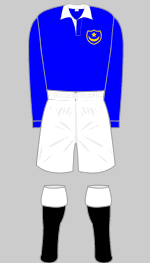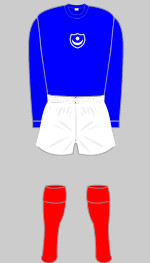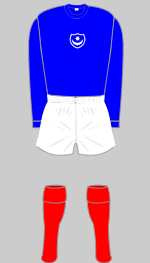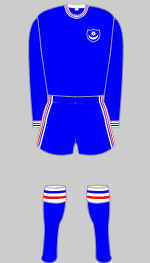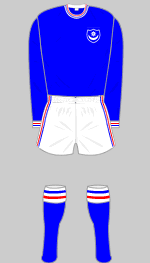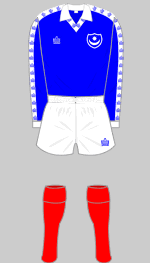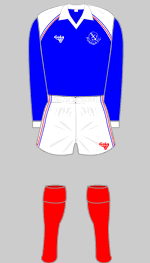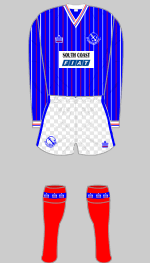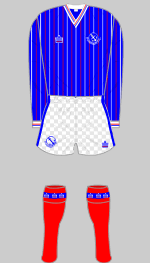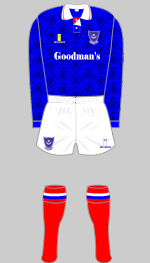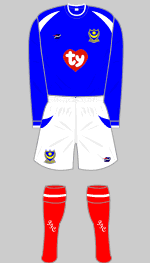


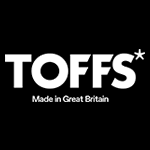

Portsmouth
Formed
1898
Wound up in 1911 and reconstituted almost immediately.
Founder member of Division Three 1920
Kit History
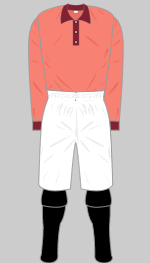
1898-1900 a p q v
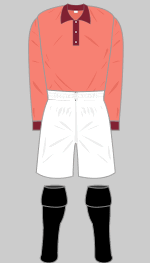
1901-1903 o q v
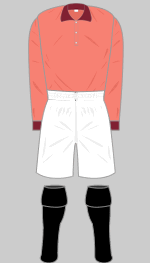
1904-1905 o q v
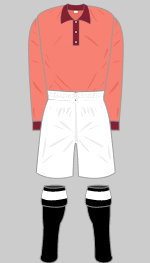
1905-1906 o q v
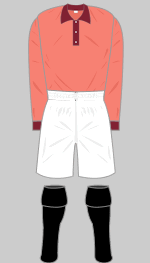
1906-1909 o p q v
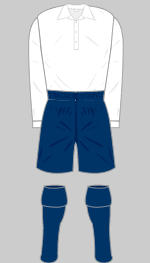
1909-1912 a
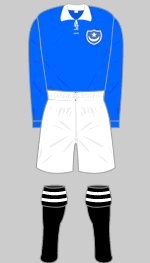
1912-1923 a o p u v
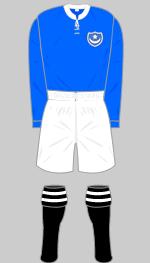
1924-1925 a p v
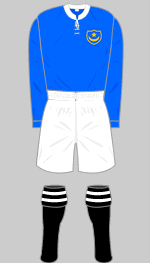
1925-1933 a o p v
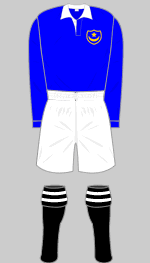
1933-1934 o
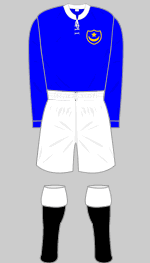
1934-1937 a o v
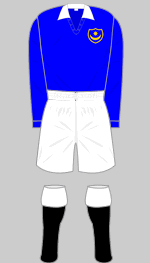
Aug-Dec 1946 s
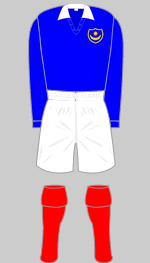
Dec 1946-1950 o s
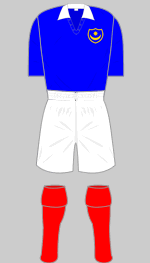
1950-1951 s

1951-1952 1 a s
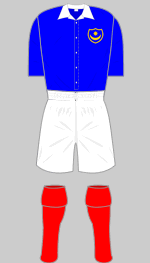
1951-1955 a o s
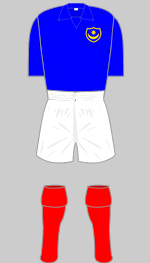
1954-1956 a s
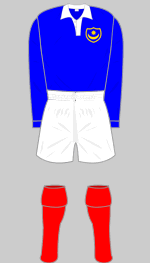
1954-1956 (2) a o s

1956-March 1958 s
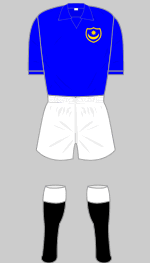
March-April-1958 o s
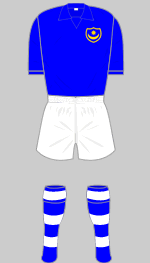
April 1958 l s
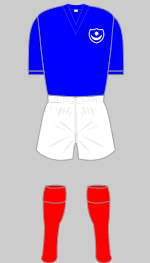
1958-1961 a s
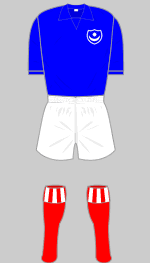
1959-1961 alt 1 n s
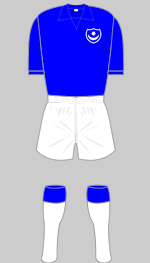
1959-1961 alt 2 s
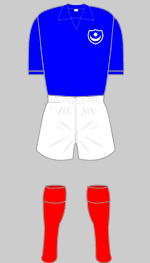
1961-1962 1 l s
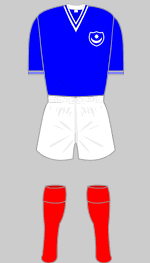
1961-1962 2 o s
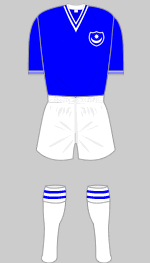
1961-1962 3 s
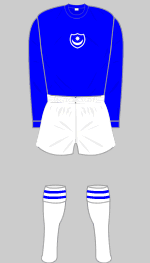
1962-1965 2 o s
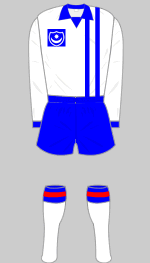
1973-March 76 a g j
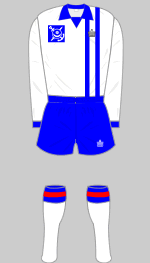
April 1976 s
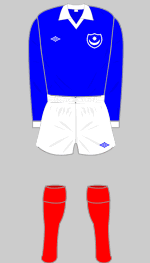
1976-1977 j
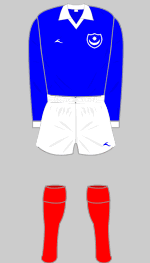
1977-1978 a j
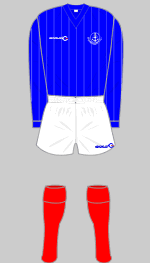
1982-1983 a
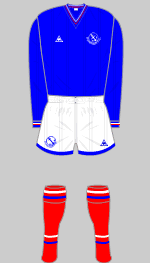
1983-1985 a f
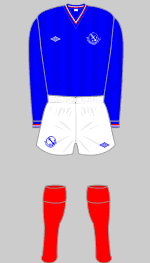
1985-1987 e g
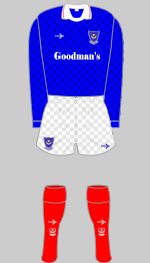
1989-1991 f r
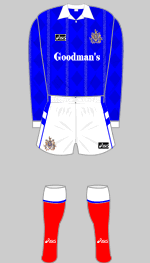
1993-1995 c l
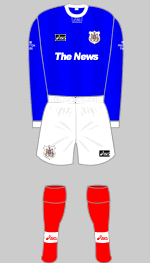
1995-1997 c i
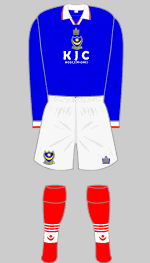
1997-1999 c
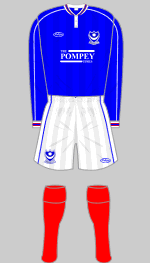
1999-2000 c
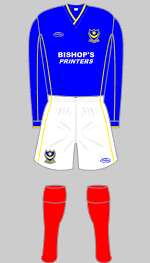
2000-2002 c
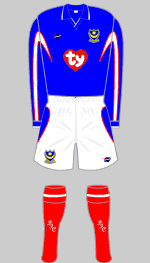
2002-2003 c
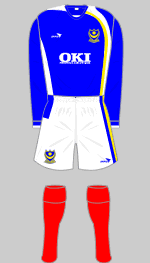
2005-2006 d
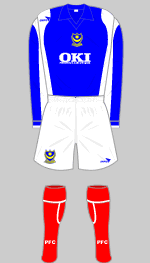
2006-2007 h
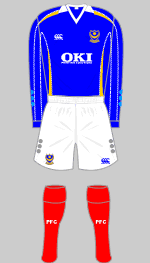
2007-2008 d
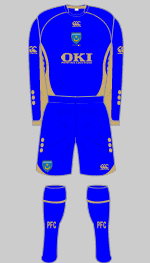
2008-2009 d m
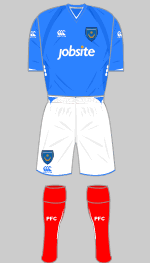
2009-2010 d
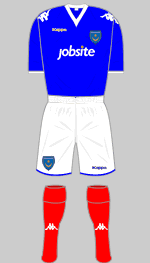
2010-2011 d
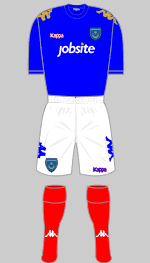
2011-2012 d
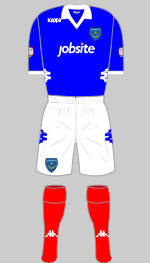
2012-2013 d
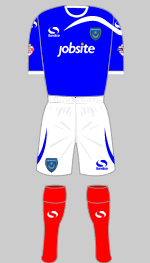
2013-2014 d
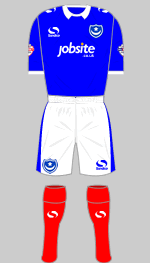
2014-2015 d
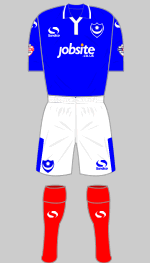
2015-2016 d
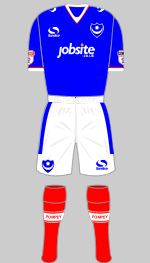
2016-2017 d
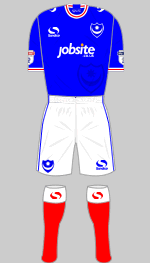
2017-2018 d
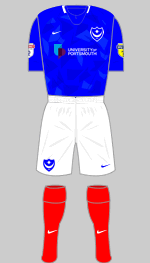
2018-2019 d
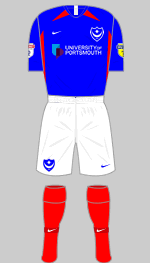
2019-2020 d
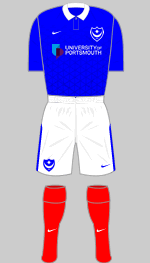
2020-2021 d
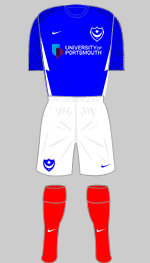
2021-2022 d
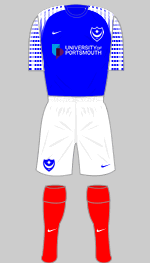
2022-2023 d
Background
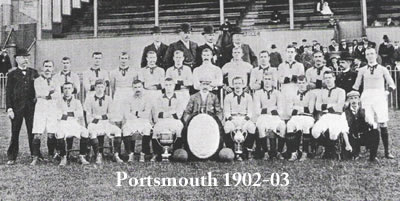 In 1898 Royal Artillery FC
were kicked out of the Southern League after breaching the strict rules on amateurism of
the period. The Army club attracted considerable support and had reached
the First Division of the Southern League. To preserve first class football
in the town, five prominent local sportsmen and businessmen formed Portsmouth
FC in April 1898. It was not until February 1899 that they appointed their first manager-secretary and started work to build a stadium on former agricultural land to be named Fratton Park. In May Portsmouth signed their first players and were admitted straight into the Southern League First Division without having to serve an apprenticeship in the lower divisions.
In 1898 Royal Artillery FC
were kicked out of the Southern League after breaching the strict rules on amateurism of
the period. The Army club attracted considerable support and had reached
the First Division of the Southern League. To preserve first class football
in the town, five prominent local sportsmen and businessmen formed Portsmouth
FC in April 1898. It was not until February 1899 that they appointed their first manager-secretary and started work to build a stadium on former agricultural land to be named Fratton Park. In May Portsmouth signed their first players and were admitted straight into the Southern League First Division without having to serve an apprenticeship in the lower divisions.
Wearing distinctive salmon pink shirts with maroon trim (the colours of the city's trams) they were nicknamed "The Shrimps," and finished as runners-up in their inaugural season. In 1902 they won the championship.
In 1909 plain white shirts and navy knickers were adopted, similar to the colours worn by the defunct Royal Artillery club.
In 1911 a severe financial
crisis struck and the club was wound up after suffering relegation to the Southern League Second Division. A new limited company was promptly formed
to take over and the club was saved after substantial guarantees were offered by the new board of directors. The new club adopted the now familiar plain
blue shirts and white shorts on returning to the Southern League First Division in 1912-13. These included the club's 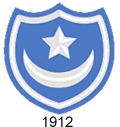 famous crest, consisting of a crescent moon and star. This motif comes from the town's coat of arms and is believed to date back as far as the time of Richard I. Curiously, the star on the original badge featured a star with five points rather than the eight that appear on the town crest.
famous crest, consisting of a crescent moon and star. This motif comes from the town's coat of arms and is believed to date back as far as the time of Richard I. Curiously, the star on the original badge featured a star with five points rather than the eight that appear on the town crest.
In 1920 the First Division of the Southern League was incorporated into the Football League as the Third Division and Portsmouth duly took their place. Their manager, John McCartney, had predicted promotion within three seasons and sure enough, in 1924 the club won the Third Division (South) title. On the last day of the 1926-27 season a late goal allowed Portsmouth to pip Manchester City for promotion to the First Division on goal average by 0.02 of a goal. This was the first time that a Third Division club had reached the top level. After two seasons fighting relegation, Portsmouth began to establish themselves, reaching the FA Cup final in 1929 and 1934.
According to Pompey People FC Who's Who 1899-2000 (Mick Cooper 2000), Jimmy (Nicholl) was at the club when the pitch was completely returfed in the summer of 1930 and was one of the first to wear the darker blue shirts which were adopted for the 1933-34 season.
In 1939, Portsmouth met a strong Wolves side in their third FA Cup final as rank outsiders but this time they won by 4-1.
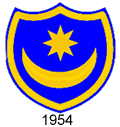 During the Second World War Portsmouth put out
strong sides because of the many servicemen stationed in the
port who had been professional footballers in peacetime. Distinctive red
stockings were adopted at Christmas 1947 at the behest of the club president, Field Marshal Montgomery to honour the fallen of the armed forces during the Second World War. Pompey
were a formidable side and won the First Division championship in 1949,
their jubilee season, and in 1950.
During the Second World War Portsmouth put out
strong sides because of the many servicemen stationed in the
port who had been professional footballers in peacetime. Distinctive red
stockings were adopted at Christmas 1947 at the behest of the club president, Field Marshal Montgomery to honour the fallen of the armed forces during the Second World War. Pompey
were a formidable side and won the First Division championship in 1949,
their jubilee season, and in 1950.
In 1954 modern, lightweight shirts were introduced and the crest was modified with an 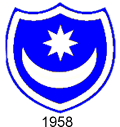 eight-pointed star replacing the earlier version, thus aligning the club's identity more closely with that of the city. In 1958 the club crest was amended again and now featured white rather than gold embroidery.
eight-pointed star replacing the earlier version, thus aligning the club's identity more closely with that of the city. In 1958 the club crest was amended again and now featured white rather than gold embroidery.
Failure to find replacements for aging players
led to gentle decline throughout the 1950s culminating in a series of disastrous seasons that took the club all the way down to Division Three
in 1961. 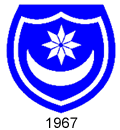
Pompey's traditional blue shirts were dropped in 1973 in an attempt to revive the team's fortunes. The novel white shirts featured two vertical blue stripes with the badge appearing on the "wrong" side. At the end of the 1975-76 season a new crest was introduced that combined the familiar moon and star with a sword and anchor, representing the Army and Royal Navy. After the  team were relegated to the Third Division at the end of the season the white shirts and novel crest were quietly dropped in favour of a more traditional strip.
team were relegated to the Third Division at the end of the season the white shirts and novel crest were quietly dropped in favour of a more traditional strip.
The late Seventies brought serious financial problems and Portsmouth slipped into Division Four in 1978.
The team's recovery started with promotion back to the Third Division in 1980. The following season a new crest was introduced that featured an anchor and a sword to symbolise the city's links with the Royal Navy and the Army respectively. Two versions appeared one of which had at its centre a football while the other replaced this with a small version of the crescent moon and sun.
The club, often described as the "sleeping giant
on the South Coast" won the Third 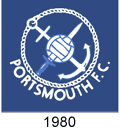 Division championship in 1983
and in 1987, Pompey returned to the First Division, albeit briefly
- they were
Division championship in 1983
and in 1987, Pompey returned to the First Division, albeit briefly
- they were 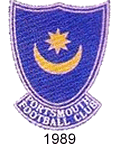 relegated in 1988. The unpopular crest introduced at the beginning of the decade was retired the following season and replaced by a more traditional badge with the addition of the club's name.
relegated in 1988. The unpopular crest introduced at the beginning of the decade was retired the following season and replaced by a more traditional badge with the addition of the club's name.
In 1992 Portsmouth reached the semi-finals of the FA Cup and the following season they reached the play-offs.
In 1993 the board decided to adopt the Portsmouth coat of arms as their club crest. This 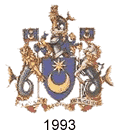 proved unpopular with supporters, many of whom thought the new badge too elaborate. Rather oddly the 1995-97 shirt had "1898 FRATTON PARK" embroidered onto the sleeves. After four years the board bowed to public pressure and in 1997 it
proved unpopular with supporters, many of whom thought the new badge too elaborate. Rather oddly the 1995-97 shirt had "1898 FRATTON PARK" embroidered onto the sleeves. After four years the board bowed to public pressure and in 1997 it 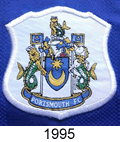 was replaced.
was replaced.
During the club's centenary season a financial crisis led to administration in December 1998. At this time there was no points penalty for clubs who took this course and Portsmouth retained their place in the second tier before Milan Mandarić bought the club in May 1999. Mandarić appointed Harry Redknapp as manager in 2002 and invested a considerable sum in pursuit of success. In 2003 Pompey were promoted to the Premier league as
Nationwide Division One champions. Redknapp resigned half way through the 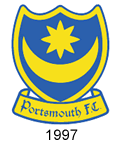 2004-05 season after a row with his chairman, and moved down the coast to manage Portsmouth's arch rivals Southampton. Less than a year later Redknapp was back and in January 2006 the club was bought by Alexandre Gaydamak, who funded record transfer dealings as Redknapp assembled a brand new squad.
2004-05 season after a row with his chairman, and moved down the coast to manage Portsmouth's arch rivals Southampton. Less than a year later Redknapp was back and in January 2006 the club was bought by Alexandre Gaydamak, who funded record transfer dealings as Redknapp assembled a brand new squad.
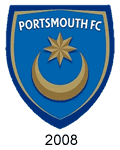 The climax of the 2007-08 season was a return to Wembley where Pompey narrowly beat Championship side Cardiff City, to win the FA Cup for the first time since 1939. Success on the field was, however, achieved by generating huge debts, which would bring the club to the brink of extinction.
The climax of the 2007-08 season was a return to Wembley where Pompey narrowly beat Championship side Cardiff City, to win the FA Cup for the first time since 1939. Success on the field was, however, achieved by generating huge debts, which would bring the club to the brink of extinction.
The following season, Pompey celebrated their 110th anniversary, adopting a new crest and an all blue kit trimmed in gold.
In May 2009 Gaydamek sold the club Sulaiman al-Fahim, a businessman from the United Arab Emirates who promised to invest £50m in the club. In fact there was no new money and in October al-Fahim sold 90% of his holdings, including several pieces of real estate near Fratton Park, to a Saudi-based businessman, Ali al-Faraj who had been behind a rival but unsuccessful bid to buy the club in May. Once again, it turned out that the new owner did not have the cash needed to keep the club running but the group fronted by al-Faraj did persuade Hong Kong based Balram Chainrai to loan them £17m. In October Daniel Azougy, an Israeli lawyer with a conviction for fraud, was appointed to restructure the club's debts, estimated to be around £60m.
Faraj was late paying the players and staff for November, December and January and the Premier League slapped a transfer embargo on the club for unpaid transfer fees. In December HM Revenue & Customs took out a winding-up order to recover unpaid VAT and PAYE. On 4 February the club, now rooted at the foot of the Premier League, was taken over by Chainrai, exercising his option to take control if loans he had made to the club were not repaid.
At the end of February 2010, Portsmouth became the first Premier League club to go into administration, suffering a nine-point deduction that virtually ensured their relegation. In his initial report the administrator estimated the club's debts to be around £80m but by the middle of May, this had risen to £140m. Remarkably, Portsmouth's season climaxed with an appearance in the FA Cup final where they were beaten by Chelsea. The club emerged from administration in October after a CVA was finally agreed with creditors, Chainrai regaining control.
On 2 June 2011 Vladimir Antonov took control of the club from Chainrai. In November Antonow was arrested as part of an investigation into alleged asset-stripping of the Lithuanian based Bankas Snoras, which was 65% owned by Antonov. Similar allegations led to the suspension of another of Antonov's banks, Latvijas Krajbanka and his assets were frozen. Antonov resigned his position at the football club when his businesses went into administration precipitating a serious cash problem and another winding-up order brought by HMRC over £1.6m in unpaid taxes. Portsmouth entered into administration for the second time in two years, prompting a ten-point penalty followed by relegation to League One. In April it emerged that the club now owed £58m and with no buyer in prospect, would likely go into liquidation at the end of the season.
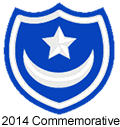 In the event, Pompey avoided liquidation but only just after the last of their senior players agreed to waive their contracts and leave days before the 10 August deadline set by the administrator. Chainrai, who was the preferred bidder and who was still owed £17m and held Fratton Park as security then dropped his bid leaving the way open for the Pompey Supporters' Trust to acquire the club and the deal was completed in April 2013, when Portsmouth came out of administration. Already relegated, the 10 point penalty imposed by the Football League made little difference and the club would have to make a fresh start in League Two.
In the event, Pompey avoided liquidation but only just after the last of their senior players agreed to waive their contracts and leave days before the 10 August deadline set by the administrator. Chainrai, who was the preferred bidder and who was still owed £17m and held Fratton Park as security then dropped his bid leaving the way open for the Pompey Supporters' Trust to acquire the club and the deal was completed in April 2013, when Portsmouth came out of administration. Already relegated, the 10 point penalty imposed by the Football League made little difference and the club would have to make a fresh start in League Two.
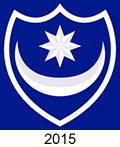 To mark the centenary of the outbreak of the First World War, the club commissioned a special shirt closely modelled on the version worn in 1914 complete with period crest. Printed into the fabric were the names of over 1400 members of the 14th and 15th (Portsmouth) Battalions, The Hampshire Regiment ("The Pompey Pals") who lost their lives
To mark the centenary of the outbreak of the First World War, the club commissioned a special shirt closely modelled on the version worn in 1914 complete with period crest. Printed into the fabric were the names of over 1400 members of the 14th and 15th (Portsmouth) Battalions, The Hampshire Regiment ("The Pompey Pals") who lost their lives 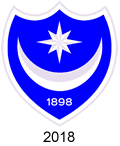 during the war. The following season, following a consultation with supporters, the eight pointed star was revived.
during the war. The following season, following a consultation with supporters, the eight pointed star was revived.
The patience and loyalty of the supporters who had kept the club alive was rewarded in 2017 when Pompey won the League Two title. For the 2018-19 season the traditional crest was given a makeover with the addition of the date of the club's formation and a revised eight pointed star.
Sources
- (a) Pompey, A Family Passion - fan site with an excellent archive of historical photographs, sadly no longer available.
- (b) Crewe Alexandra FC (Images of Sport)
- (c) empics
- (d) Portsmouth Official Website
- (e) Football Focus
- (f) True Colours (John Devlin 2005)
- (g) Pete's Picture Palace
- (h) Tom Darbyshire
- (i) David King
- (j) Alick Milne
- (k) Christopher Worrall
- (l) Simon Monks
- (m) Football Shirt Culture
- (n) John O'Shaughnessy
- (o) Keith Ellis (HFK Research Associate)
- (p) Pompey, the History of Portsmouth FC (Mike Neesom, Mick Cooper and Doug Robinson 1984) provided by Richard Essen
- (q) Jason Stone
- (r) Michael Saunders
- (s) Tony Sealey
- (t) Dick Waite
- (u) Football & the First World War
- (v) Michael Comben (Pompey History Society)
Photograph courtesy of Pompey, the History of Portsmouth FC (Neesom, Cooper & Robinson 1984). Crest artwork 1913-1989 provided by Jason Stone. Crests are the property of Portsmouth FC.
